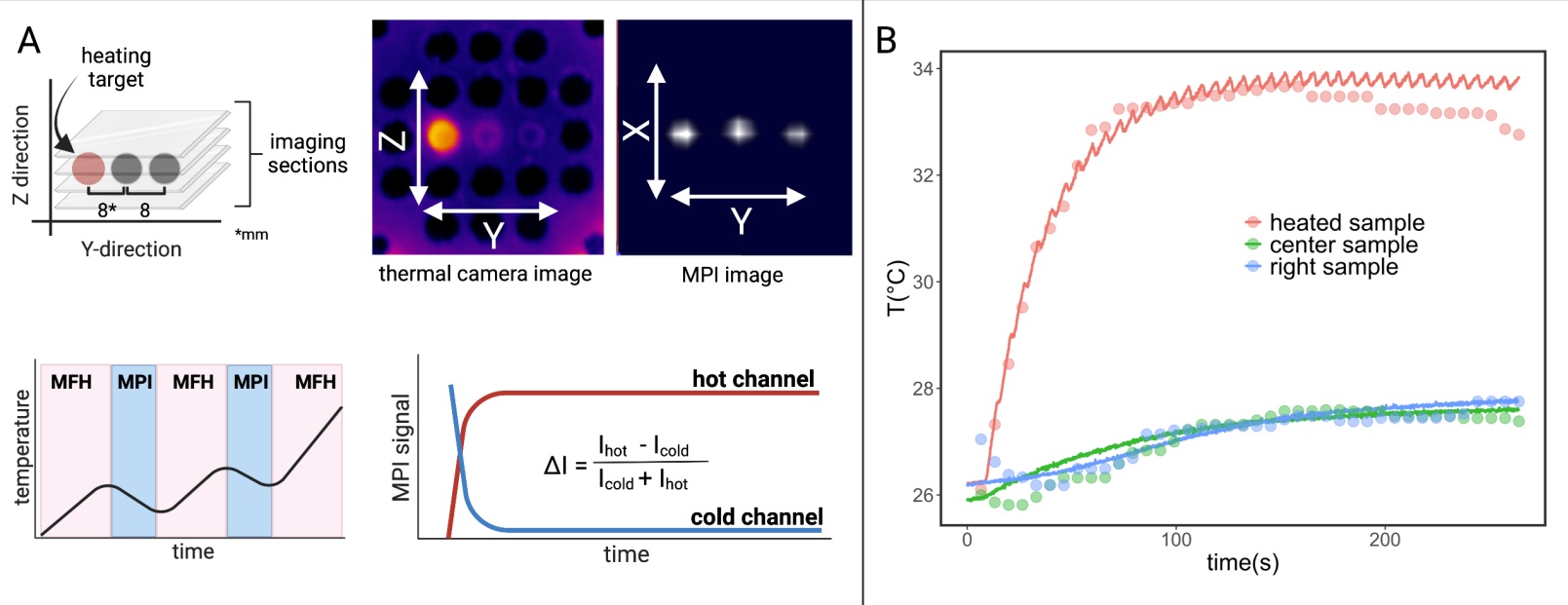Magnetic Hyperthermia
Magnetic Hyperthermia for cancer treatments and targeted drug delivery
Synergizing Diagnostics and Therapy: Theranostics with Magnetic Particle Imaging and Magnetic Fluid Hyperthermia
In the realm of medical science, the parallel pursuit of diagnosis and therapy has long been a hallmark of patient care. In recent years the combination of diagnostic and therapy has shown new possibilities as the success of a treatment can be supervised and controlled, which gives birth to the concept of “theranostics.” Originally coined to depict the dual application of substances in nuclear medicine, theranostics has evolved to encompass the integration of imaging and treatment within a single device. In this narrative, the fusion of Magnetic Particle Imaging (MPI) and Magnetic Fluid Hyperthermia (MFH) emerges to a new approach, holding unprecedented potential for the field.
Magnetic Particle Imaging (MPI) Central to our exploration is Magnetic Particle Imaging (MPI), a groundbreaking tomographic imaging technique that enables the non-invasive quantification of magnetic nanoparticles. The foundational principle of MPI, introduced in 2005, hinges upon the interaction of magnetic nanoparticles with an alternating magnetic field – a “drive field” – that induces changes in their magnetization. These particles respond nonlinearly, generating a distinctive signal detectable by a receiving system. This signal, characterized by multiple harmonics of the drive frequency, exhibits a linear relationship with SPION concentration, rendering MPI a quantitative and sensitive imaging modality.
The amalgamation of a static magnetic gradient field – a “selection field” – positioned to create a field-free region (FFR) at its center, enables spatial encoding of the particle signal. Within the FFR, particles contribute to image signals, while those outside the FFR become magnetically saturated and do not substantially affect the received signal. The temporary particle behavior of in vivo, subject to metabolic changes, further extends the potential for longitudinal monitoring, and their responsiveness to environmental factors like temperature introduces avenues for MPI-based thermometry.
Magnetic Fluid Hyperthermia (MFH) MFH capitalizes on the inherent heating capabilities of magnetic particles when subjected to high-frequency alternating magnetic fields (AMF). This energy dissipation phenomenon, known as Néel fluctuations, manifests as heating – a promising avenue for therapeutic intervention. The heating efficiency, quantified by the specific-absorption rate (SAR), is influenced by particle properties such as shape, material properties and size. The combination of MPI and MFH is especially potent due to the shared spatial encoding mechanism. The selection field, responsible for spatial encoding in imaging also confines the region of heating in MFH. As the FFR can be steered using static magnetic fields, a local selection of heating is possible.
MPI-MFH for Unprecedented Theranostic Impact The fusion of Magnetic Particle Imaging and Magnetic Fluid Hyperthermia holds large potential in the realm of theranostics. By interleaving tomographic MPI with locally restricted MFH (MPI-MFH), the technology offers many possibilities in cancer treatment or targeted drug delivery. The combination of these modalities empowers clinicians with interesting new capabilities. The same platform facilitates not only the visualization of particles with high sensitivity and precision, but also the regulation and monitoring of temperature changes during therapeutic interventions.
Our current research expands upon this success, introducing tomographic MPI interleaved with locally confined MFH while harnessing MPI-based thermometry to finely control achieved temperatures. Local heating in an interleaved MPI-MFH scenario was recently demonstrated in our paper In situ theranostic platform uniting highly localized magnetic fluid hyperthermia, magnetic particle imaging, and thermometry in 3D.
References
2023
-
 In situ theranostic platform uniting highly localized magnetic fluid hyperthermia, magnetic particle imaging, and thermometry in 3DSep 2023
In situ theranostic platform uniting highly localized magnetic fluid hyperthermia, magnetic particle imaging, and thermometry in 3DSep 2023